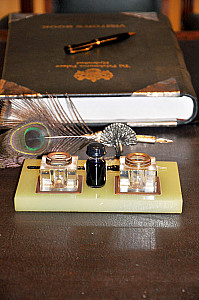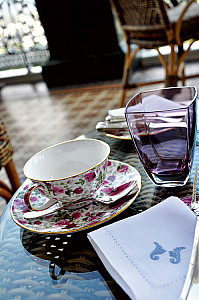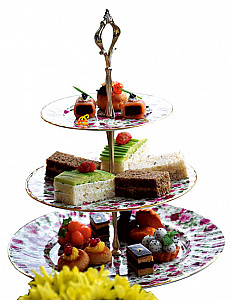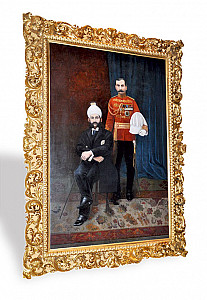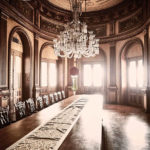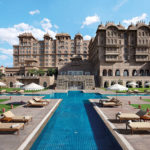Living The Fantasy
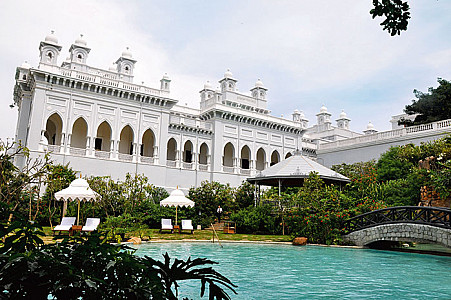
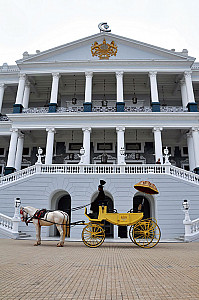
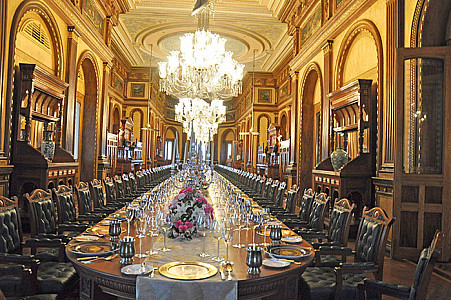
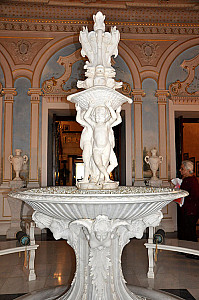

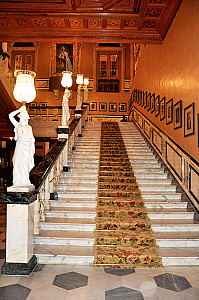
The complex which stood above the town on its own acropolis, was falling into ruin, with every window and doorway sealed by red wax. Wiping the windows, I could see cobwebs the size of bedsheets hanging from the corners of the rooms. The skeletons of outsized Victorian sofas and armchairs lay dotted around the parquet floors, their chintz upholstery eaten away by white ants. Outside, the gardens had given way to scrub flats, waterless fountains and paint-flaking flagpoles at crazy angles. It was a truly melancholy sight.
– William Dalrymple in 1997
On a windy November morning as the Jaguar glides slowly up the hill, we get glimpses of the pearl grey and white palace through clumps of foliage till the purr of the engine is drowned by an impatient neighing. Our royal chariot awaits. Driven in style by a pair of white steeds to the main entrance, the Verve group follows the path of a regal sceptre being carried up the marble stairs as rose petals are showered upon us from the heavens above. We, princesses for a weekend? Why not, we decide as adabs follow us all the way to our rooms. The Italian-designed palace, we are told, is laid out like a scorpion with two stings spread out as wings in the north. An aerial view would perhaps give a better idea but for now, we absorb the fountains and never-ending gardens – the scorpion’s belly.
In the resplendent setting of my room as I watch Barack and Michelle doing a jig with Indian school kids on the plasma, a turbaned gent runs a lavender bath for me in an old-fashioned tub. There are fruity treats and chocolates in the seating area and a butler on call if I want the drapes to be drawn, or undrawn or any other stressful job I can’t do on my own. The furnishings are lavish, the carpets soft and the bed fit for a queen. Am I in the erstwhile harem quarters? I believe so. The suites, across the courtyard, named after the swashbuckling Mughals, get grander and pricier, befitting their plush quotient. The Nizam’s Suite, akin to five-star Presidential Suites, comes for a cool five lakhs per night. It flaunts two living rooms, a private verandah circling a cloud-shaped pool and a landscaped garden with the kingly bedroom up a flight of stairs. Bill Gates might like this one.
Built in 1893 by Nawab Viqar-ul-Amra, (born under the zodiac sign of Scorpio), who had a passion for building palaces, Falaknuma later became the Nizam’s state guesthouse, welcoming such luminaries as Tsar Nicholas II, Archduke Ferdinand, King George V and Queen Mary. In fact, it is the marble busts of the latter that occupy prime space in the hall that connects the cherub-infused, frescoed lobby with the rooms and restaurants beyond. As we continue our stroll, an imperial lifestyle of the past unfolds.
The room with the walnut-toned desk is where the last ruling Nizam sat, writing with his peacock feather ‘pen’ even as his favourite 184 carat Jacob diamond doubled up as a paperweight. Years later, the sparkler was discovered in his shoe by his grandson! The family who owned the Golconda mines were among the richest in the world and the Falaknuma Palace, replete with treasures from all the continents has often been compared to the magnificence of Versailles in France and Schonbrunn in Austria. We ascend a cantilevered marbled staircase flanked by portraits of the past and Greek deities and wander into the very Victorian Jade Room, enriched by hand-painted ceilings, elegant straight-backed chairs and bulging chandeliers, then onto the adjoining terrace to relive the Nizam’s much loved ritual – afternoon tea. A chintz print tea set (specially crafted for the Taj) bearing a saffron-ginger brew arrives, followed by an English spread of scones and cream and tiny tartlets topped with scoops of fresh fruit and lemon curd. Twilight descends and as the 400-year-old city of Hyderabad sprawled 2000 feet below us switches on its twinkling lights, we are princesses surveying our kingdom.
And the Baroque-style palace is our domain. Each room we explore speaks of a languorous legacy, when women whispered behind lace veils in ‘gossip corners’ and men played billiards at a table especially customised by London’s Burroughes and Watts. The library, seemingly plucked out of Windsor Castle is a warmly panelled space housing an extensive collection of books, many of them first editions of which a select few are accessible to the curious visitor. But in the swirl of rich brocade, carved balustrades and tinkling cut glass, the most gasp-worthy interior has to be the 101-seater dining hall. The emperor’s table, the longest in the world, stretches across a vast hall and is laden with Versace crockery, thick candelabra, silver cutlery, watched over by thousand-piece Belgian chandeliers. It is all quite spectacular. We check out the much-lauded acoustics, conversing with each other from opposite ends of the table and yes, we can hear every spoken word! Contemporary guests do not eat in this hallowed space so we make our way to Adaa, the fine dining Indian restaurant where Hyderabadi biryani, slow-cooked haleem and tender shaami kababs are dished out with suitable flourishes in an ambience that calls for prolonged celebration.
History reveals that Mukarram Jah, the last Nizam, (now in his 70s and ailing), grew so weary of family feuds and the upkeep of his sumptuous estates in Hyderabad that after his grandfather’s death he embraced the inconspicuous life of a sheep farmer in Australia leaving the palaces ripe for ruin. It is one of these, the Falaknuma, that the Taj Group has buffed to life again through a painstaking process lasting more than ten years. Each fragment of carpet, shred of tapestry, cracked porcelain, has been replicated or restored staying true to the original, with much help from Princess Esra, already in the city overseeing arrangements for the big launch party the following weekend.
Freshly tingling from being pummelled with poppy paste at the Jiva spa we suddenly spot her. Clad in an aubergine salwar kameez, this daughter of Turkish nobility, first wife of Jah (and he had five), mother of a Hollywood cameraman, strides across the courtyard with her entourage of interior decorator, bodyguard, palace historian. She stops to greet us while chiding a worker about over scrubbing a wall. Some antiquity must be preserved even in refurbishment!
Falaknuma means ‘mirror of the sky’. From a crumbling edifice overrun by white ants and plundered beyond shame, it is after 40 years, Hyderabad’s most exclusive address.
William Dalrymple, were he to visit now, would be truly astounded.
Related posts from Verve:
Verve Trending
Sorry. No data so far.
us on Facebook to stay updated with the latest trends

